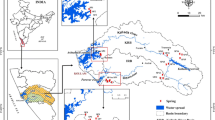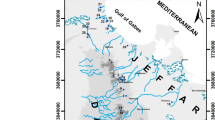Abstract
Thermal springs are attractive geological features interesting for tourists because of their balneological and therapeutic applications. In Iran, the thermal springs surrounding Mount Sabalan are famous and unique in this regard. Two clusters of thermal springs consisting of 16 springs and mostly used as spas occur in Neer and Meshkinshahr areas. In order to investigate the seasonal changes of field and chemical parameters and to trace element concentrations in dry and wet seasons, springs were sampled twice in May and November. Field data including T, EC, pH and Q were measured on-site and major cations and anions were analysed in the laboratory along with 72 trace elements. Cations show the following order of abundance: Na ≫ Ca ≥ K > Mg and anions follow the order of Cl > HCO3 > SO4. Trace element concentrations indicate that most of the elements show concentrations well beyond the standard guideline values for drinking water. pH, T, spring discharge and elevation are not correlated with each other and with other parameters, indicating that they have had no role on concentrating or depleting trace elements in spring waters. While the two sets of samples were taken within a 6 month interval, the elements and parameters show slight or no variation from the first period to the second and in some cases, they show less than 5 % decrease or increase in the second sampling period. Correlation coefficient and principal component analysis of analytical data indicate that EC, K, Cl, HCO3, As, B, Ba, Br, Li, Na, Rb, Sr and V show very strong mutual correlation coefficients implying their relationship and common source and fate in the hydrothermal fluid that carries them out of the geothermal system. Moreover, they all fall in the component 1 of PCA. This group of elements is supposed to be derived from the magmatic-hydrothermal system through the interaction of hydrothermal fluids with the rocks they have passed through. The mean As value is 160-fold higher than the guideline values (10 μg/l) and Mn and Sb shows an exceedance of 12- and 11.5-fold, respectively. Arsenic shows a variation of 5–5,834 μg/l. Hence, it is supposed that potentially toxic elements may have adverse effects on tourists using the springs as a treatment or recreation. Indeed, the discharge of springs with high values of As and other elements represents a threat for downstream water uses. The higher concentrations of most elements including As, Pb, S, Cl and Sb and the higher pH values found in Neer area springs seem to be more related to an older hydrothermal system present in this area than the Meshkinshahr system that is still active today.





Similar content being viewed by others
References
Aghanabati A (2006) Geology of Iran. Geological Survey of Iran Publications (in Farsi), Iran
Aiuppa A, D’Alessandro W, Federico C, Palumbo B, Valenza M (2003) The aquatic geochemistry of arsenic in volcanic groundwaters from southern Italy. Appl Geochem 18:1283–1296
Aiuppa A, Federico C, Allard P, Gurrieri S, Valenza M (2006a) Trace metal modelling of groundwater–gas–rock interactions in a volcanic aquifer: Mount Vesuvius, Southern Italy. Chem Geol 216(3–4):289–311
Aiuppa A, Avino R, Brusca L, Caliro S, Chiodini G, D’Alessandro W, Favara R, Federico C, Ginevra W, Inguaggiato S, Longo M, Pecoraino G, Valenza M (2006b) Mineral control of arsenic content in thermal waters from volcano-hosted hydrothermal systems: insights from island of Ischia and Phlegrean Fields (Campanian Volcanic Province, Italy). Chem Geol 229:313–330
Amini B (1994) Geological map of Meshkin Shahr, scale 1:100,000. Geological Survey of Iran, Iran
Bagnato E, Parello F, Valenza M, Caliro S (2009) Mercury content and speciation in the Phlegrean Fields volcanic complex: evidence from hydrothermal system and fumaroles. J Volcanol Geotherm Res 187:250–260
Bargagli R, Cateni D, Nelli L, Olmastroni S, Zagarese B (1997) Environmental impact of trace element emissions from geothermal power plants. Arch Environ Contam Toxicol 33:172–181
Brombach T, Marini L, Hunziker JC (2000) Geochemistry of the thermal springs and fumaroles of Basse-Terre Island, Guadeloupe, Lesser Antilles. Bull Volcanol 61:477–490
Chudaev O, Chudaeva V, Sugimori K, Kuno A, Matsuo M (2006) Geochemistry of recent hydrothermal systems of Mendeleev Volcano, Kuril Islands, Russia. J Geochem Explor 88:95–100
Cruz JV, França Z (2006) Hydrogeochemistry of thermal and mineral water springs of the Azores archipelago (Portugal). J Volcanol Geotherm Res 151:382–398
Davraz A (2008) Hydrogeochemical and hydrogeological investigations of thermal waters in the Usak Area (Turkey). Environ Geol 54:615–628
Elhatip H, Afsin M, Kuscu I, Dirik K, Kurmac Y, Kavurmaci M (2004) Estimation of environmental impacts on the water quality of Incesu-Dokuzpinar Springs in Kayseri, Turkey. Bull Eng Geol Environ 63:255–260
Federico C, Aiuppa A, Favara R, Gurrieri S, Valenza M (2004) Geochemical monitoring of groundwaters (1998–2001) at Vesuvius volcano (Italy). J Volcanol Geotherm Res 133:81–104
Gemici U, Filiz S (2001) Hydrochemistry of the Cesme geothermal area in western Turkey. J Volcanol Geotherm Res 110:171–187
Gemici U, Tarcan G (2004) Hydrogeological and hydrogeochemical features of the Heybeli Spa, Afyon, Turkey: arsenic and the other contaminants in the thermal waters. Bull Environ Contam Toxicol 72:1107–1114
Gemici U, Tarcan G, Colak M, Helvaci C (2004) Hydrogeochemical and hydrogeological investigations of thermal waters in the Emet area (Kutahya, Turkey). Appl Geochem 19:105–117
Gultekin F, Hatipoglu E, Ersoy AF (2011) Hydrogeochemistry, environmental isotopes and the origin of the Hamamayagi-Ladik thermal spring (Samsun, Turkey). Environ Earth Sci 62:1351–1360
Guo Q, Wang Y (2009) Trace element hydrochemistry indicating water contamination in and around the Yangbajing geothermal field, Tibet, China. Bull Environ Contam Toxicol 83:608–613
Jamadi M (2010) Study of hydrothermal alterations and their extent in Sabalan geothermal field. NW Iran unpublished MS thesis, School of Geology, University of Tehran (In Farsi)
Karakaya N, Karakaya MC (2001a) Hydrothermal alteration of the Şaplıca volcanic rocks, Sebinkarahisar. Turk Int Geol Rev 43(10):953–962
Karakaya N, Karakaya MC (2001b) Mineralogic and geochemical properties of hydrothermal alteration types of Şaplıca (Şebinkarahisar, Giresun) volcanites. Geol Bull Turk 44(2):75–89
Karakaya N, Karakaya MÇ, Nalbantçılar MT, Yavuz F (2007) Relation between spring-water chemistry and hydrothermal alteration in the Şaplıca volcanic rocks, Şebinkarahisar (Giresun, Turkey). J Geochem Explor 93:35–46
Kralj P (2004) Trace elements in medium-temperature (40–80 °C) thermal waters from the Mura basin (North-Eastern Slovenia). Environ Geol 46:622–629
Lima A, Cicchella D, Di Francia S (2003) Natural contribution of harmful elements in thermal groundwaters of Ischia Island (Southern Italy). Environ Geol 43:930–940
Loppi S (2001) Environmental distribution of mercury and other trace elements in the geothermal area of Bagnore (Mt Amiata, Italy). Chemosphere 45:991–995
Modabberi S, Moore F (2004) Environmental geochemistry of Zarshuran Au–As deposit, NW Iran. Environ Geol 46(6–7):796–807
Pehlivan R (2003) The effects on human health and hydrogeochemical characteristics of the Kirkgecit and Ozancik hot springs, Canakkale Turkey. Environ Geochem Health 25:205–217
Pentecost A, Jones B, Renaut RW (2003) What is a hot spring? Can J Earth Sc 40:1443–1446
Pirajno F (2009) Hydrothermal processes and mineral systems. Springer, New York
Porkhial S, Kosari A, Yousefi P (2010) Updated geological data from the drilling of the NW Sabalan geothermal project, Iran. In: proceedings of world geothermal congress, Bali, Indonesia, 25–29 Apr 2010
Sanliyuksel D, Baba A (2011) Hydrogeochemical and isotopic composition of a low-temperature geothermal source in northwest Turkey: case study of Kirkgecit geothermal area. Environ Earth Sci 62:529–540
Stocklin J (1968) Structural history and tectonics of Iran, a review. Am Assoc Pet Geol Bull 52(7):1229–1258
Tarcan G, Gemici U, Aksoy N (2005) Hydrogeological and geochemical assessments of the Gediz Graben geothermal areas, western Anatolia, Turkey. Environ Geol 47:523–534
Tassi F, Vaselli O, Capaccioni B, Macias JL, Nencetti A, Montegrossi G, Magro G (2003) Chemical composition of fumarolic gases and spring discharges from El Chichon volcano, Mexico: causes and implications of the changes detected over the period 1998–2000. J Volcanol Geotherm Res 123:105–121
USEPA (2009) List of contaminants and their MCLs. http://water.epa.gov/drink/contaminants/upload/mcl-2.pdf. Accessed 10 Sept 2012
Valentino GM, Stanzione D (2003) Source processes of the thermal waters from the Phlegraean Fields (Naples, Italy) by means of the study of selected minor and trace elements distribution. Chem Geol 194:245–274
Valentino GM, Stanzione D (2004) Geochemical monitoring of the thermal waters of the Phlegrean Fields. J Volcanol Geotherm Res 133:261–289
Valentino GM, Cortecci G, Franco E, Stanzione D (1999) Chemical and isotopic compositions of minerals and waters from the Campi Flegrei volcanic system, Naples, Italy. J Volcanol Geotherm Res 91:329–344
Vengosh A, Helvaci C, Karamanderesi IH (2002) Geochemical constraints for the origin of thermal waters from western Turkey. Appl Geochem 17:163–183
WHO (2011) Guidelines for drinking-water quality, 4th edn. World Health Organization, Geneva
Yalcin T (2007) Geochemical characterization of the Biga Peninsula thermal waters (NW Turkey). Aqaut Geochem 13:75–93
Yoshizuka K, Nishihama S, Sato H (2010) Analytical survey of arsenic in geothermal waters from sites in Kyushu, Japan, and a method for removing arsenic using magnetite. Environ Geochem Health 32:297–302
Author information
Authors and Affiliations
Corresponding author
Rights and permissions
About this article
Cite this article
Modabberi, S., Jahromi Yekta, Ss. Environmental geochemistry and sources of potentially toxic elements in thermal springs in the Sabalan volcanic field, NW Iran. Environ Earth Sci 71, 2821–2835 (2014). https://doi.org/10.1007/s12665-013-2660-0
Received:
Accepted:
Published:
Issue Date:
DOI: https://doi.org/10.1007/s12665-013-2660-0




